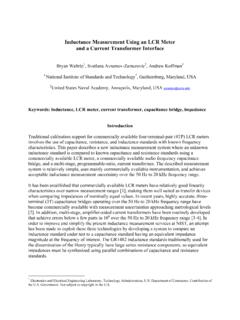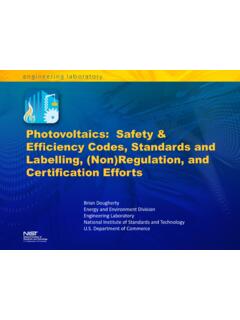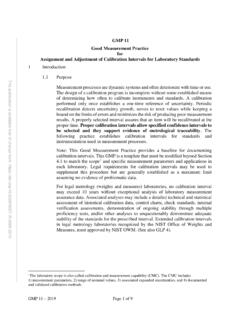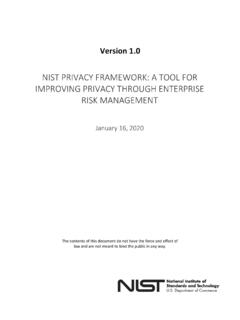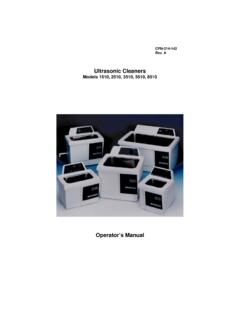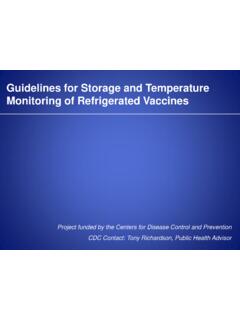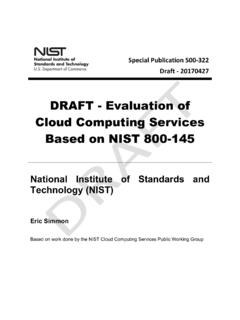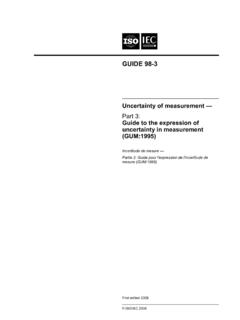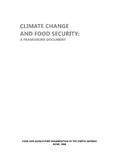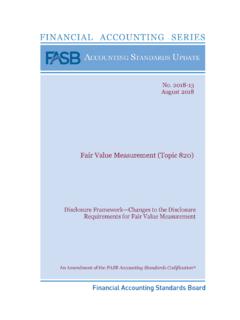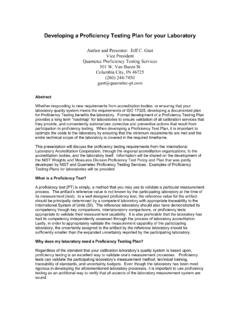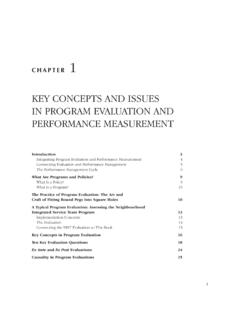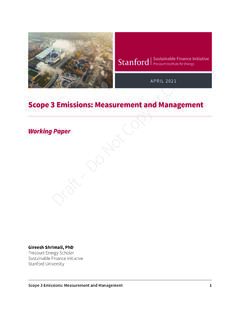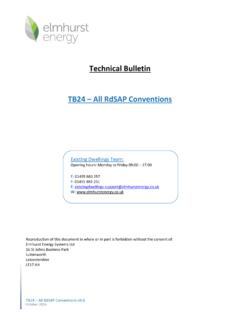Transcription of DRAFT - NIST
1 (Numerical Designation) This document has been accepted by the Academy Standards Board (ASB) for development as an American National Standard (ANS). For information about ASB and their process please refer to This document is being made available at this stage of the process so that the forensic science community and interested stakeholders can be more fully aware of the efforts and work products of the Organization of Scientific Area Committees for Forensic Science (OSAC). The documents were prepared with input from OSAC Legal Resource Committee, Quality Infrastructure Committee, and Human Factors Committees, as well as the relevant Scientific Area Committee. The content of the documents listed below is subject to change during the standards development process within ASB, and may not represent the contents of the final published standard. All stakeholder groups or individuals, are strongly encouraged to submit technical comments on this DRAFT document during the ASB s open comment period.
2 Technical comments will not be accepted if submitted to the OSAC Scientific Area Committee or Subcommittees. Standard for Barrel and Overall Length Measurements for Firearms DRAFT DOCUMENT DRAFT (Numerical Designation) i Standard for Barrel and Overall Length Measurements for Firearms Keywords: barrel, bore, firearm, integral chamber, length, measurand, revolver, rifle, shotgun, uncertainty This standard describes procedures for measuring the barrel length and overall length of firearms and for estimating the uncertainty of those measurements. Estimation of uncertainty is achieved through repeated measurements by all lab personnel responsible for barrel length and overall length measurements. Annex A provides an example illustrating measurement results and describes several other sources of measurement uncertainty . DRAFT (Numerical Designation) ii Foreword Barrel lengths and overall lengths are dimensional specifications of firearms commonly mandated by criminal law.
3 Procedures are outlined here for measuring these quantities on three different types of firearms to determine their conformance to the specifications. Methods for determining the uncertainty of barrel length and overall length measurements are also described and illustrated here. This standard was proposed by the Subcommittee on Firearms and Toolmarks (SCFT) of the Organization of Scientific Area Committees (OSAC) by submitting a request to the American Academy of Forensic Sciences (AAFS) Academy Standards Board (ASB). It is based on a guideline describing the measurement procedures originally developed by the Scientific Working Group for Firearms and Toolmarks (SWGGUN). SCFT has added procedures for the estimation of uncertainty , a crucial component for establishing measurement traceability. DRAFT (Numerical Designation) iii Acknowledgements Editor: To be determined Drafting Working Group Members: Name Organization Theodore Vorburger (SCFT) Associate, Nat l Institute of Standards and Technology Max Morris (SCFT) Iowa State University Chris Monturo (SCFT) Miami Valley (Ohio) Regional Crime Laboratory Nick Petraco (SCFT Affiliate) John Jay College of the City University of New York Erich Smith (SCFT, SWGGUN) Federal Bureau of Investigation Consensus Group (SCFT) Members: To be determined DRAFT (Numerical Designation) iv Table of Contents Acknowledgements.
4 Iii Table of Contents .. iv 1 Scope .. 1 2 Normative References .. 1 3 Terms and Definitions .. 1 4 Requirements .. 1 5. Conformance .. 5 Annex A .. 6 Annex B .. 6 DRAFT (Numerical Designation) 1 1 Scope This standard is intended for firearm examiners conducting barrel and overall length measurements for firearms. The calculation of uncertainty for these types of measurements is required and is illustrated with examples. 2 Normative References ATF National Firearms Act Handbook. Department of Justice Bureau of Alcohol, Tobacco, Firearms and Explosives Office of Enforcement Programs and Services [Internet]: ATFE-Publication [Revised April 2009], Chapter 2; available at: , and (reviewed Sept. 22, 2016) referenced below as ATF-NFA. JCGM 200:2012, International Vocabulary of Metrology Basic and General Concepts and Associated Terms (VIM 3rd edition); #gum.
5 JCGM 100:2008, Evaluation of measurement data Guide to the expression of uncertainty in measurement (GUM); #gum. Association of Firearm and Tool Mark Examiners, Glossary, 6th Edition, Version (2013), referenced below as AFTE Glossary. 3 Terms and Definitions For the purposes of this document, the following definition applies. Measurand quantity intended to be measured (VIM, Sec. ) Terms Specific to Firearms Terms specific to firearms, such as muzzle, bore, forcing cone, breech face, action, chamber, barrel, firing pin, and bolt are described in the AFTE Glossary. 4 Requirements Background United States federal laws, state laws, and international laws contain requirements for the minimum barrel lengths and minimum overall lengths of both rifles and shotguns. These requirements may vary for different jurisdictions. Examples of minimum length requirements in federal law [ATF-NFA] include: 16 inch barrel length for rifles, 18 inch barrel length for shotguns, and 26 inch overall length for both rifles and shotguns.
6 The procedures, measurements, and calculations for assessing barrel and overall lengths against the applicable specifications follow. DRAFT (Numerical Designation) General When handling any firearm, even for the purposes of measuring, safety is the first concern. Make sure the firearm is unloaded before conducting measurements. If there is any doubt about the operation of a firearm, consult with a qualified firearms instructor (if available), protocols, or manufacturers literature before handling a firearm for measuring. When measuring barrel or overall length, ensure that the firearm is free from movement and stable for measuring and is located in an area with proper lighting and that the measuring devices have current calibration certificates that provide traceability to the international unit of length through accredited calibration laboratories. Common devices used to measure barrel and overall lengths (BL-OL) are measuring tapes, steel rulers, measuring rods, and caliper devices.
7 The unique identifier(s) for the device(s) used shall be recorded in the examination record. Measurements for altered or uneven barrels should include the longest portion. Measurands: The quantities to be measured for BL-OL are described in ATF-NFA. Briefly, The ATF procedure for measuring barrel length is to measure from the closed bolt (or breech-face) to the furthermost end of the barrel , and The overall length of a firearm is the distance between the muzzle of the barrel and the rearmost portion of the weapon measured on a line parallel to the axis of the bore. Figure 1. Illustration of barrel length (BL) and overall length (OL) measurands (adapted from ATF-NFA) Additional provisions and highlights are described in Sections , , and Barrel Length Measurements Revolvers When measuring a revolver barrel, the distance parallel to the bore axis from the rear of the forcing cone to the farthest end of the muzzle represents the length of the barrel.
8 DRAFT (Numerical Designation) Ruler/Measuring Tape: A revolver barrel may be measured by placing a steel ruler/measuring tape on the exterior of the barrel, parallel to the axis of the bore to determine the barrel length. The ruling marks shall then be perpendicular to the muzzle bore. Measuring Rod: A measuring rod may be used to measure barrel length; however, it may be difficult to determine the starting point for the measuring rod. Consideration must be taken to determine how the starting point can be accurately achieved. A block at the muzzle or forcing cone end of the firearm, which is perpendicular to the axis of the bore, may be used to represent the starting point for the measuring rod to determine barrel length. The material of the measuring rod shall be sufficiently soft that it does not scratch the barrel. Caliper: A revolver barrel may be measured by placing a caliper on the exterior of the barrel, parallel to the axis of the bore to determine the barrel length.
9 Integral Chamber Barrels When measuring the barrel of a firearm that has an integral chamber, the distance parallel to the bore axis from the muzzle end to the breech face (with the action closed) represents the length of a barrel. All measurements are made perpendicular to the bore axis at the farthest point of the barrel. Ruler/Measuring Tape: An integral chamber barrel can be measured by placing a steel ruler/measuring tape on the exterior of the barrel, parallel to the axis of the bore. Measuring rod: Before measuring an integral chamber barrel, ensure that the firing pin is not impeding the measuring rod from making contact with the breech face. It may be necessary to cock the firearm in order to withdraw a protruding firing pin. In the case of a fixed firing pin, be certain it is not reducing the barrel length measurement . Ensure that the measuring rod, when inserted in the barrel, is parallel to the bore axis.
10 Overall Length Measurements When measuring the overall length of a firearm, the measurement shall be taken along a line which is parallel to the axis of the bore from a perpendicular tangential line which touches the rearmost point of the firearm to a perpendicular tangential line that touches the furthest point of the muzzle. The overall firearm length shall be determined using a measuring platform or fixture that can provide indications of length increments parallel to the bore axis illustrated in Fig. 1. uncertainty for Barrel and Overall Length Measurements Estimating the uncertainty of length measurements is essential to achieving traceability of the measurements to the international unit of length. This section provides essential steps for laboratory studies to estimate the uncertainty of those BL-OL measurements that are reported by the laboratory to external parties.
